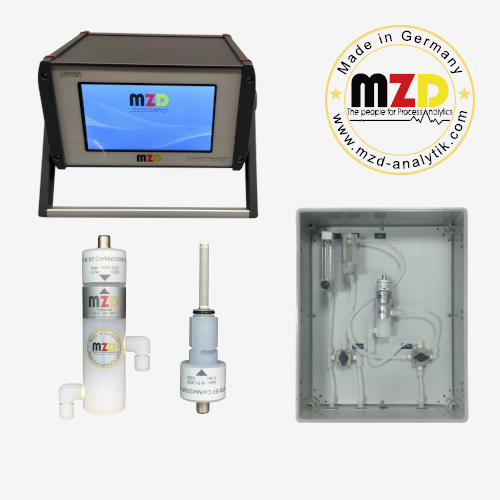
SMART-MT Trace Moisture analyzer for Measurement and Application of Chlorine and Hydrogen Chloride Moisture in Polysilicon and Monocrystalline Silicon
1. Overview
1.1 Introduction
Polycrystalline silicon is a form of monolithic silicon. When molten monolithic silicon solidifies under subcooling conditions, the silicon atoms are arranged in a diamond lattice pattern into many nuclei, and if these nuclei grow into grains with different crystallographic orientations, the grains combine and crystallize into polycrystalline silicon.
1.2 Application
Widely used in the manufacture of semiconductor radios, tape recorders, refrigerators, color TVs, VCRs, electronic computers and other basic materials. In recent years, polysilicon has been used in large quantities for solar energy utilization, playing a huge role as monocrystalline silicon. Although in terms of application practice, to make solar power generation has a large market, accepted by the majority of consumers, it is necessary to improve the photoelectric conversion efficiency of solar cells and reduce production costs.
2. Polysilicon production process
At present, the main traditional processes for international polysilicon production are: modified Siemens method and silane pyrolysis method.
2.1 Modified Siemens Process
On the basis of the Siemens process, a closed-loop cycle is realized by adding a dry recovery system for the reduction tail gas and a SiCl4 hydrogenation process, thus forming the modified Siemens process - a closed-loop SiHCl3 hydrogen reduction process. The production process of the modified Siemens method is to synthesize HCl (or purchased HCl) using chlorine and hydrogen, HCl and industrial silicon powder at a certain temperature to synthesize SiHCl3, then SiHCl3 is separated and purified by distillation, and the purified SiHCl3 is subjected to chemical vapor deposition reaction in the hydrogen reduction furnace to obtain high purity polysilicon.
Quartz sand is smelted and purified to 98% in an electric arc furnace to produce industrial silicon: SiO2+C→Si+CO2↑
Industrial silicon is crushed and reacted with anhydrous hydrogen chloride (HCl) in a fluidized bed reactor to produce silicon trichloride (SiHCl3) to be dissolved: Si+HCl→SiHCl3+H2↑
The purified silicon trichloride is deposited by a high temperature reduction process to produce polysilicon by the reduction of highly pure SiHCl3 in an H2 atmosphere: SiHCl3+H2→Si+HCl.
2.1.1 Advantages of Modified Siemens Method
1) Energy saving:
Since the modified Siemens method uses multiple pairs of rods and a large diameter reduction furnace, it can effectively reduce the electrical energy consumed by the reduction furnace.
2) Reduction of material consumption: The modified Siemens method provides effective recovery of reduction tail gas.
It is the mixture of gases emitted from the reduction furnace, after the reaction. The modified Siemens method recycles all the various components in the tail gas, which can greatly reduce the consumption of raw materials.
3) Reduction of pollution:
Since the modified Siemens method is a closed-circuit system, the various materials in the polysilicon production are fully utilized, and very little waste is discharged, which controls pollution and protects the environment compared to the traditional Siemens method.
2.2 Silane pyrolysis method
Silane is produced by silicon tetrachloride hydrogenation method, silicon alloy decomposition method, hydride reduction method, and direct hydrogenation method of silicon. The produced silane gas is then purified and produced in a pyrolysis furnace to produce polysilicon in rod form with high purity.
2.2.1 Advantages of the silane method:
1) Combined energy consumption per kg of polysilicon product is more than one-third lower than that of the Siemens method.
2) The by-products of the silane-based process do not cause major environmental hazards and are environmentally friendly polysilicon processes
3) Lower production costs than the Siemens process, which provides a cost advantage
4) Since silane gas is not corrosive while trichlorosilicon is highly corrosive, the silane process requires less process piping and equipment than the Siemens process, and the total investment in the production process system is lower than that of the Siemens process.
5) Because the silane process is simpler than the Siemens process, the silicon-fired process has a smaller footprint than the Siemens process and is a land-intensive polysilicon process.
6) Lhe silicon powder produced in the silane method polysilicon can be used in the casting method polysilicon wafer products, solving the problem of silicon powder utilization
7) Silane is non-corrosive, with low thermal decomposition temperature and high decomposition rate, so the purity and yield of silicon polysilicon obtained by this method are high.
2.2.2 Disadvantages of silane pyrolysis method
Silane gas is a flammable and explosive gas, which requires high gas tightness of the system, so the hardware construction standard of the system is required to be high; moreover, on the basis of excellent hardware, the safety production management must also be strengthened, and strict management is necessary to avoid accidents such as combustion and explosion caused by the leakage of silane gas.
3. Reasons why system pipeline leakage is difficult to avoid in polysilicon production
3.1 In the modified Siemens method, it is necessary to use Cl2 to generate HCl gas, and Cl2 and HCl gas are corrosive gases, easily dissolved in water to generate strong acid HCl liquid. It is easy to corrode the pipeline after a long time.
3.2 In the silane thermal decomposition method, HCl gas will also be generated, which will also corrode the pipeline after dissolving in water.
4. Difficulties to overcome
The process Cl2 and HCl are dried and the dried gas need to be monitor the trace moisture which is less than 100ppm to ensure that the gas is dry and to prevent corrosion of the piping when it dissolves in water.
5. SMART-MT trace moisture analyzer features
High measurement accuracy, stable operation, long service life, moderate price and low maintenance cost. Ceramic sensor is resistant to HF, SO2 corrosion, low cost of use (no calibration required, regular regeneration of probe coating with 40% phosphoric acid).
